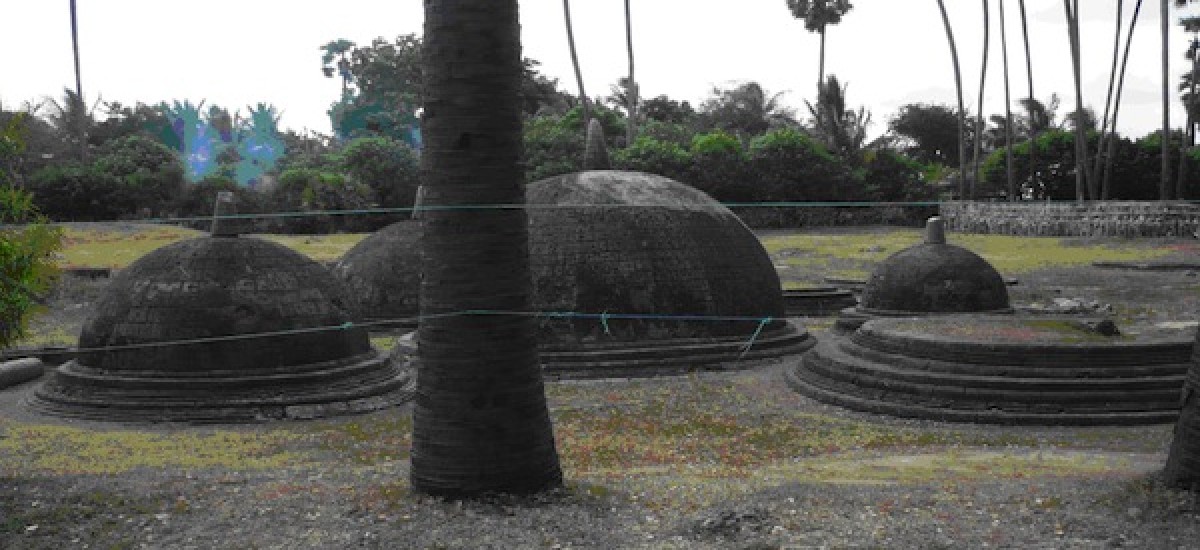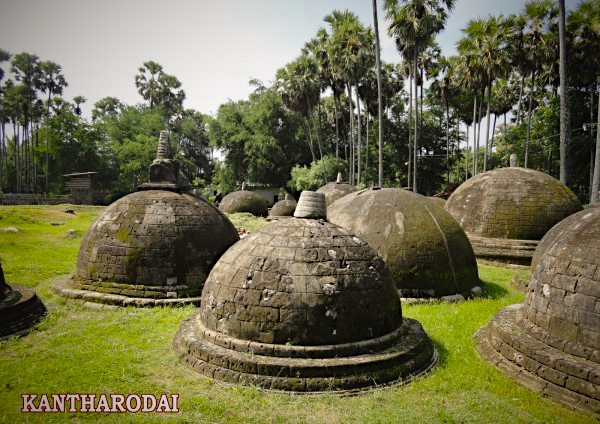[Editors note: Also listen to podcast by author here.]
The end of the war is certainly not the end of the conflict that led to the military confrontation between the military forces of Sri Lanka state and the Liberation Tigers of Tamil Eelam (LTTE). This conflict surfaces in different guises, the military episode being only one. It is well-known that conflicting interpretations of the past of the island by conflicting parties is a major factor in the conflict.[1] When the military confrontation was the dominant form of the conflict, the importance of other forms were less evident. With the military episode completely over, non military aspects of the conflict are again coming to the fore. It is in this context that the renewed role of “history” in the Sri Lanka ethnic conflict has to be discussed.
In the collective imagination of the ‘Sinhala-Buddhist South’, the ‘Tamil North’ occupies a very special place. In short, it is a place to be conquered and occupied. To the Sinhala-Buddhist mind the “North” is very much part of the Sinhala-Buddhist territory. This territory has long been illegitimately occupied by Tamils, or, according to more sophisticated versions, occupied mostly by former Sinhalese who have metamorphosed into Tamils following some maneuvering by elite groups and European colonial rulers. Sinhala nationalist propagandists such as Nalin de Silva and Suriya Gunasekera have been the most vocal and strident proponents of this view.[2] Although this explanation is restricted to a limited group who are very well familiar with their literature, there is a general consensus among ordinary Sinhala-Buddhists about the Sinhala-Buddhist ownership of the North.
This Sinhala-Buddhist perception towards the Tamil North is very much part of the ideology of the Post-Colonial Sri Lanka state. In this ideology, the territorial integrity of the state is articulated in a very special way. In the minds of the Sinhala-Buddhist, “Lankawe ekeeyabhwaya” (Unity/unitariness of Sri Lanka) is not a notion of modern territorially based statehood or constitutionalism, but a historically constituted notion that is well represented in the Sinhala-Buddhist parlance “dedahas pansiya wasarak tisse pevethi ekeeya rajjaya” (United state that existed for the last 2500 years).
The notion of island (dvϊpa) formed part of the ruling ideology of Anuradhapura, at least at the time of the compilation of the Mahawamsa in the 6th century CE. Apparently there were two sources of this ideology of ‘islandness’. One is the outsiders’ perception where the geographical entity was identified as a social entity as well. For reasons that are not clear, a powerful group of inhabitants in the island, at least a section of which formed the ruling elite of Anuradhapura, came to be known as sīhala and the island was named by many outsiders as the ‘Island of sīhalas (sīhaladīpa or its variant serendib as pronounced by Arabians). The other source of this ideology is the world view of the bikkhus (community of Buddhist monks) who were a decisive social group in the pre-modern historical development of the island. The idea that the ‘island’ is the place destined to preserve Buddhism in its pure form for five thousand years was central to the world view that was propagated by a dominant section of the bikkhu community, who were probably close to the ruling elite. The notion dammadϊpa perfectly encompassed this world view. Attempts were made through mythical traditions to link this world view with the wishes of living Buddha himself, where he prepared the island for the ordained task by visiting the island three times and asking the god sakra to protect Wijaya and his retinue.[3]
Through the articulation of this ideology, the post-colonial ruling elite sanctified the existing territoriality of the state. In the context that the existing territoriality is being constantly put into question by the Tamils not only though alternative ideology but also politico-military means, upholding this sanctified tradition is immensely significant.
Although the comprehensive military victory over the LTTE was celebrated on a massive scale and the entire Sinhala-Buddhist populace responded to it as if they achieved the ultimate victory over the Tamil North, there is also wider acceptance, at the same time, that the mission is not fully accomplished.[4] There are a number of fronts to fight in: taming and de-nationalizing Tamil politics, discrediting the Tamil Diaspora, changing the demography in the North, etc. In addition, the reconstitution of the “historic” Sinhala-Buddhist North (and East) is also recognized as a prominent task.
Post-war politico-ideological interventions in relation to the North are fascinating and quite significant. Apart from continued military presence and “development process” as defined by the Sinhala state in line with neo-liberalism, there are other ideologically driven interventions. Pilgrimage has become one such phenomenon. Sinhala-Buddhist pilgrims who are flocking into Jaffna peninsula in large numbers I will argue are engaged in a politico-ideological act rather than a religious act. Beneath the official rhetoric of bringing about ethnic harmony through North-South people to people encounters, these pilgrimages reproduce conflicting interests between Sinhala and Tamil ethno-nationalist identity politics. Although pilgrimage has provided much needed economic benefits for the North, they have at the same time created a sense of anxiety among politically and ideologically conscious Tamils.
The major ideological inspiration for these Sinhala-Buddhist pilgrims is arguably the discourse of “Sinhala-Buddhist heritage in the North and East” (uturu negenahira Sinhala bauddha urumaya). The most vigorous propagators of this ideology, with the moral, institutional, material and political support of the state and, particularly unofficial backing of the military, became very active in the post-war context. In their point of view the most important task of the post-war reconstitution of the North (and East) is to re-establish the historical rights of the Sinhala-Buddhists in this territory.[5]
Photo courtesy Transcurrents
As permanent residents of the North territory are unlikely to be converted to the Sinhala-Buddhist ideology, the strategy that propagators of the Sinhala-Buddhist ideology have adopted is to create an alternative and parallel space of social relations in competition with that of Tamils. It is possible to compare this strategy with the one that Sinhala-Buddhists have adopted in relation to Buddhist sites in India.
Buddhist sites in North India and Nepal, for which Sinhala-Buddhists use the name dambadiva form a part of the imaginary Sinhala-Buddhist territory. Dambadiva, as found in the Sinhala Buddhist imagination, is not a location of the geography of South Asia. Therefore dambadiva vandanava is a pilgrimage to the imagined part of the Sinhala-Buddhist territory. Moreover, this is not a visit to a foreign land either. The usual term rata yanava (going abroad) would not be used for this journey. It would simply be referred to as dambadiva yanava (going to dambadiva, not even ‘going to India’).
If the ultimate realization of the Sinhala-Buddhist territoriality in relation to dambadiva is the pilgrimage, the case of North-bound pilgrimage is different. As mentioned at the beginning, the North, unlike dambadiva, is, in the mind of the Sinhala-Buddhist, a place to be conquered and occupied. If they are satisfied, in the case of dambadiva, only with preserving Buddhist sites in India as pilgrim destinations, something more has to be achieved in the North. As a religious act of ordinary devotees, pilgrimage to the North is of course an end in itself. For the politically and ideologically conscious pilgrims, this is more than that. They are quite conscious of the broader significance of their journey. They share the view that the historical sequence that linked the modern Sinhala-Buddhist with early Buddhist affairs in the island has been broken in the North by way of de–buddhisization and de–sinhalization and its Sinhala-Buddhist heritage has to be re-established.
The decisive feature of this post-war Sinhala-Buddhist imagination of the North is that it is solely based on the historical consciousness of Sinhala-Buddhists and runs completely against the Tamil nationalist and Southern non-nationalist political imaginations of the post-war North. In particular, it runs against the notion of ‘traditional Tamil homelands’ which is the political core of the Tamil historical consciousness.
There is an important factor that gives an extra advantage to the Sinhala-Buddhist historical consciousness. The historical narrative that is linked with the latter is generally compatible with the dominant paradigm of the modern historical scholarship in Sri Lanka. That is the reason why dominant figures in the Sri Lankan historical scholarship such as K.M. de Silva have questioned the ‘traditional Tamil homeland’ theory as mythical and grounded in political interests of Tamil nationalism, without trying to question the mythical basis of the dominant paradigm, which supports the Sinhala-Buddhist consciousness and the political interests of the Sinhala-Buddhist ruling elite.[6]
Conclusion
From the point of view of a post-war reconciliation that should accommodate the legitimate demands of Tamils in the North and East, the renewed importance of ‘history’ in shaping the post-war dynamics of the ethno-political conflict will certainly pose a major challenge to those who wish to overcome the horizons of nationalist imaginations in a new post-war rethinking of politics. In a context where extreme Sinhala-Buddhist nationalism is unprecedentedly strong and ideologically aggressive, providing the ideological support for the political system that excludes Tamils, the need to build an alternative discourse of history becomes more than a naïve academic pursuit. It is a profound political and ideological task that has to be given a high priority.
###
This essay is part of a series on the theme of post war reconciliation, justice and development initiated by the International Center for Ethnic Studies, (ICES). Colombo. The views expressed are the author’s own and does not necessarily represent the views of the ICES.
[1] For a review of the role of “history” in the conflict see, Gunawardana, RALH, Historiography in a Time of Ethnic Conflict: Construction of the Past in Contemporary Sri Lanka, (Social Scientists’Association: Colombo)1995. also see, Coomaraswamy, Radhika, ‘Myths without Conscience: Tamil & Sinhalese Nationalist Writings of the 1980s’ in Abeysekera, C. and Gunasinghe, N. (eds.) Facets of Ethnicity in Sri Lanka (Social Scientists Association: Colombo) 1987.
[2] Both these writers mainly write in Sinhala Prof. Nalin de Silva’s writings are available online in www.kalaya.org. Dr. Suriya Gunasekera’s writings on this subject mainly appear in Divaina Sinhala newspaper. For a systematic elaboration of this approach to the history of Sri Lankan Tamils see the following work which is heavily influenced by Prof. Nalin de Silva’s work: Jayasumana, Channa Sudath, Demala Janathawage Sankshiptha Itihasaya (“The Short History of Tamil People”) (Visidunu Publishers: Boralesgamuwa) 2009.
[3] For a comprehensive analysis into the mythical tradition that link living Buddha with the Lanka island see, Gunawardana, RALH, ‘Kinsmen of the Buddha: Myth as a political charter in the ancient and early medieval kingdoms of Sri Lanka’, in Sri Lanka Journal of Humanities vol. 2 No. 1, pp.53-62, 1976
[4] Again Prof. Nalin de Silva and many prominent supporters of the government articulate this view. Prof. de Silva, in particular, clearly states that the Tamil problem will be solved only if, and when, Tamils in Sri Lanka agree to accept “the history of the land” and Sinhala-Buddhist as legitimate owners of the island. See De Silva, Nalin, Ape Pravada 3 (Our Theories 3) (Visidunu Publishers: Boralesgamuwa), 2010.
[5] Works of Rev. Ellavala Medhananda, a leader of the Jathika HelaUrumaya and a member of parliament, is very important in this connection. He is passionately involved in collecting epigraphic records pertaining to the early history of North and East. He also promotes the Sinhalization of place names in the North under the pretext that Sinhala names are the original ones. Such examples are Sinhalized Mūladīpa in place of Tamil Mulathiv and Kandurugoda in place of Kandarodai.
[6] See De Silva, KM, The Traditional Homelands of the Tamils, Separatist Ideology in Sri Lanka: A Historical Appraisal’ Tamil Home Lands, (ICES: Kandy) 1995. Although he alludes to the works that analyze the mythical aspects of the dominant paradigm, their political and ideological significance is not questioned in the same way that he has done in relation to the traditional homelands myth of Tamils.



